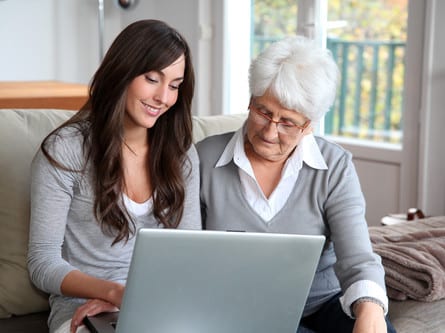
Combining interactions with the young and the old allow both generations the ability to learn not only more about each generation but also the latest trends, technology and teenagers are provided with a role model as they grow into tomorrow’s adults.
There has been a body of research over the years that shows the health benefits for the both. In particular the older generation, as it allows them to see the world through younger eyes helping to improve health outcomes, reduce depression and relieve boredom.
It’s not only beneficial for seniors but for the young ones also.
Initiating intergenerational activities allow teenagers the opportunity to share moments with seniors and open conversation where they will see similar experiences as they were young once too. They have a wealth of knowledge and advice to impart, having made mistakes, lived through a challenges and experienced many great experiences.
A recent pilot program run by Year 9 students at Davidson High School and Feros Village Byron Bay showed obvious benefits for teens too. The aims of the pilot were to connect students and seniors through virtual technology. A total of 8 senior residents at the facility took part, with the average age 93 years old. During the call students asked candid questions covering topics that ordinarily would not be discussed from the older generation:
There have been a number of changes over the decades on how people initiate ‘first dates’, with residents reporting in the olden days ice skating or local dances were all the rave and the youngsters reporting online technology as the main outlet these days. One thing that hasn’t changed about dating though they both agreed was the feeling of ‘first date nerves’.
Resident and participant, 91 year old Barrie didn’t hold make when it came to imparting his advice on dating. His tip was simple “Don’t be afraid, be bold!”
“We enjoyed life with less” another resident shared.
“We were still slaves to fashion but it wasn’t constantly changing, it was achievable. Clothes were well-made and the fashion lasted for years – one jumper and one skirt was all that was needed. We had to have the right hat though!”
A significant difference between the two generations was the aged that participants left school. With the majority of the older participants reporting to have left school by the age of 14 years.
One of the teachers at Davidson High School, Jen Wright said the students preconception before they started the pilot chat was that the seniors would be “old, frail and sick”. Which was a vast contrast to the engaging and spritely conversations they had, where the learnt that in many ways nothing has changed across the generations.
The students has such a great time and made comments along the lines of ‘That was sooo awesome’, ‘Fred is such a cool dude’, ‘I could listen to Nina all day’, ‘I want to be Jilli when I’m older’.
Mrs Wright shared “I wanted to teach the students to use technology in a positive way, and I really appreciate the wisdom of older generations, so it made sense to combine the two. I had seen Feros Care on Sunrise last year and knew they were leaders in using technology to connect their residents to the community so I wanted to welcome them into the school.
“It’s definitely something we’ll do again – we just need to iron out a few technology glitches,”.
Positive experiences came from both side and 97 year old resident Emily said “I didn’t mind telling my story – it’s so different to today, we never swore (except in the paddock). I hope the students learnt something they would never have heard anywhere else. I thought that not all is lost between the generations if they asked us questions. It was great because it made us all think about our childhoods and youth,” she smiled.
Seniors and students connected virtually using Feros Care’s “telepresence robot” called Wheel.I.Am. Wheel.I.Am is essentially an iPad mounted on a miniature Segway base, and can be remotely controlled from anywhere in the world over the internet and using a secure connection. It uses a front facing camera with 360 degree mobility and receives real-time video and audio.
During the discussion three mobile phones rang – and they were all answered by the seniors!